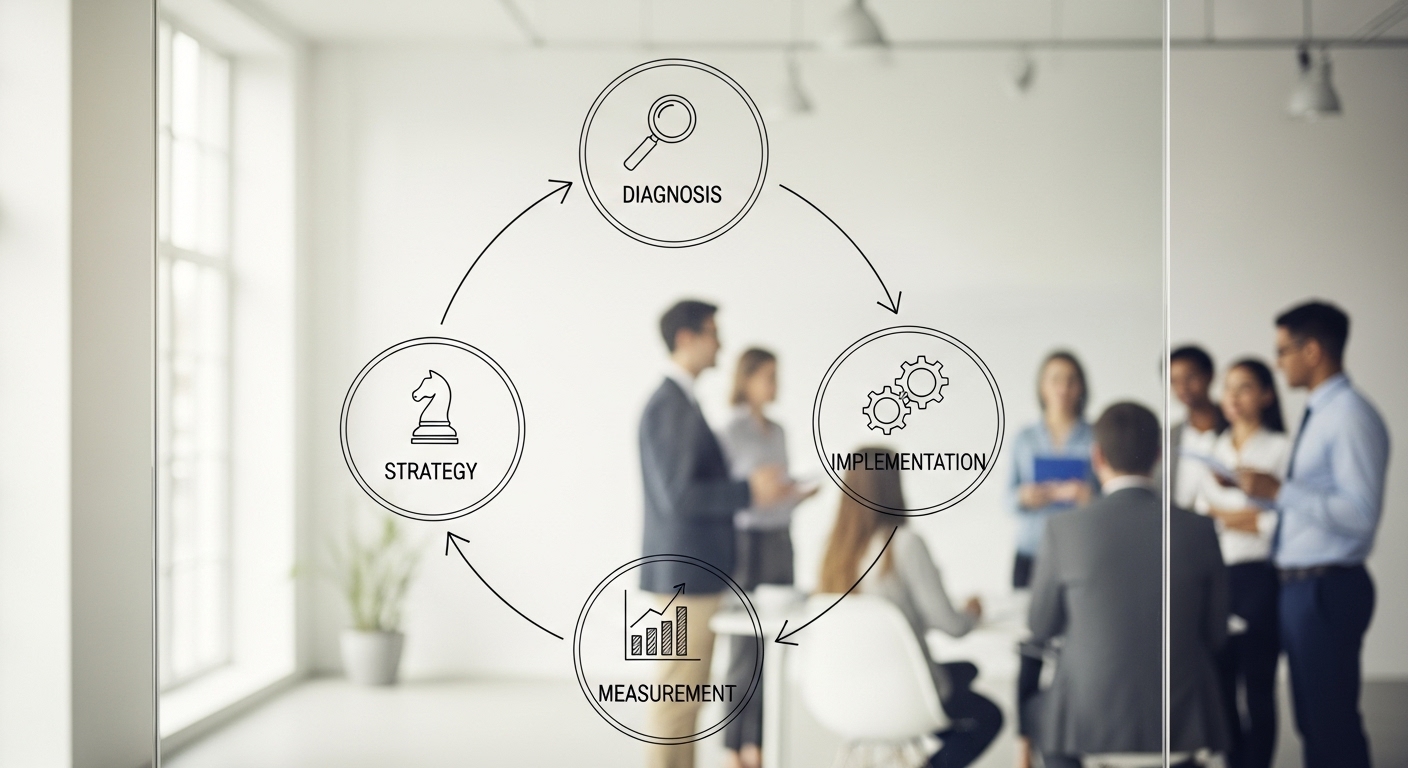In today’s fast-paced business environment, the difference between merely being busy and being truly productive has never been more critical. Many organizations fall into the trap of constant activity, mistaking motion for progress. True operational efficiency, however, is not about simply cutting costs or making people work harder; it’s a strategic imperative that transforms your operations from a necessary cost center into a powerful engine for growth, resilience, and competitive advantage. Recent search trends highlight a significant shift from isolated quick fixes to holistic, sustainable systems. Business leaders are no longer just asking ‘how can we be faster?’ but ‘how can we build a system that is inherently fast, adaptable, and intelligent?’ This requires a fundamental change in perspective—moving away from one-off projects and towards a continuous, self-optimizing loop. This article introduces The Full-Cycle Advantage, a comprehensive 5-stage framework designed to embed operational efficiency deep within your organization’s DNA, covering everything from initial diagnosis and strategic planning to tech-enabled implementation, rigorous measurement, and a culture of perpetual improvement.
Stage 1: The Diagnostic Deep Dive – Pinpointing Inefficiency
Before you can optimize a system, you must first understand it with absolute clarity. The initial stage of achieving operational efficiency is a diagnostic deep dive that goes far beyond surface-level assumptions. The goal is to identify the precise points of friction, waste, and delay—the hidden bottlenecks that drain resources and stifle productivity. A primary tool in this stage is comprehensive process mapping. This involves visually charting every step of a key workflow, from start to finish, to reveal redundant tasks, unnecessary handoffs, and logical gaps. This isn’t just a theoretical exercise; it should be informed by direct observation and data. The lean manufacturing concept of a ‘Gemba walk’—where leaders go to the actual place where work is done—is invaluable here. By observing processes firsthand and speaking with the employees who execute them daily, you gain insights that are impossible to see from a spreadsheet. Data analysis provides the quantitative backbone for these qualitative observations. By analyzing metrics like cycle time, lead time, and error rates, you can pinpoint exactly where delays occur and quantify their impact. Modern process mining software can automate this discovery, using system logs to create a dynamic and objective map of your real-world operations, but even simple tools like employee surveys and structured interviews can unearth significant inefficiencies. This stage concludes not with a solution, but with a well-defined problem statement, backed by both qualitative and quantitative evidence, which sets the foundation for a targeted and effective strategy.
Stage 2: Strategic Blueprinting – Designing for Flow
With a clear diagnosis in hand, the next stage is to design a targeted solution. Strategic blueprinting is about architecting new workflows and reallocating resources to create a state of ‘flow,’ where work moves smoothly and predictably through the system with minimal waste. This is where foundational efficiency methodologies like Lean and Agile come into play. The core principle of Lean is the elimination of ‘Muda’ (waste), which comes in many forms: overproduction, waiting, unnecessary transport, over-processing, excess inventory, and defects. Your blueprint should systematically address the wastes identified in Stage 1. For example, if the diagnosis revealed excessive waiting time between departments, the strategy might involve creating cross-functional teams or redesigning the information handoff process. Agile principles, borrowed from software development, contribute flexibility and responsiveness. Instead of designing a massive, monolithic overhaul, an agile approach breaks the implementation down into smaller, manageable sprints, allowing for adjustments based on real-world feedback. A critical component of this stage is intelligent resource allocation. This means ensuring that your most valuable assets—your people, technology, and capital—are focused on the highest-impact activities. Your strategic blueprint is more than just a list of fixes; it’s a cohesive roadmap that aligns operational changes with broader business goals, outlining clear objectives, timelines, and responsibilities for the path forward.
Stage 3: Tech-Enabled Implementation – Automating and Augmenting
A well-designed strategy is only as good as its execution. Stage 3 focuses on implementing the blueprint, with a strong emphasis on leveraging technology to automate repetitive work and augment human capabilities. Automation is a cornerstone of modern operational efficiency. Robotic Process Automation (RPA), for instance, can take over rule-based, high-volume tasks like data entry, report generation, or invoice processing. This not only eliminates human error and drastically speeds up processes but also frees up employees to focus on more strategic, value-added work that requires critical thinking and creativity. Beyond task automation, integrated software platforms like Enterprise Resource Planning (ERP) and Customer Relationship Management (CRM) systems play a crucial role in breaking down information silos. When data flows seamlessly between departments, handoffs become smoother and decision-making becomes faster and more informed. However, technology is an enabler, not a silver bullet. Successful implementation hinges on effective change management. As the Harvard Business Review often notes, resistance to change is one of the biggest hurdles to operational transformation.
“The greatest danger in times of turbulence is not the turbulence; it is to act with yesterday’s logic.” – Peter Drucker
Clear communication about the ‘why’ behind the changes, comprehensive training on new tools and processes, and involving employees in the implementation process are non-negotiable steps to ensure buy-in and adoption. This stage is about a symbiotic relationship between people and technology, where each augments the other to achieve a level of performance that neither could reach alone.
Stage 4: Measurement and Metrics – Quantifying the Gains
If you can’t measure it, you can’t improve it. This maxim is the heart of Stage 4, which is dedicated to establishing a robust system for tracking performance and quantifying the impact of your efficiency initiatives. Without clear metrics, improvements are purely anecdotal and it’s impossible to know if your changes are truly working. The first step is to define the right Key Performance Indicators (KPIs) that align with your strategic goals. These can vary widely by industry and function but often include metrics such as: Cycle Time (the total time to complete a process), Takt Time (the rate at which you need to complete a product to meet customer demand), First Pass Yield (the percentage of products or services completed without rework), and Overall Equipment Effectiveness (OEE) for manufacturing environments. For knowledge work, metrics might focus on project completion rates, task throughput, or client satisfaction scores. The key is to select a balanced set of indicators that provide a holistic view of performance. Once defined, these KPIs must be made visible. Creating real-time dashboards using business intelligence (BI) tools allows leaders and teams to monitor performance at a glance, spot emerging issues before they become critical, and celebrate wins. This data-driven visibility fosters accountability and replaces subjective opinions with objective facts, enabling more intelligent and agile decision-making across the organization.
Stage 5: The Iteration Engine – Cultivating Continuous Improvement
The final and most crucial stage transforms operational efficiency from a one-time project into a perpetual, self-sustaining system. Stage 5 is the iteration engine that makes the entire framework a true cycle. This is where the Japanese concept of ‘Kaizen,’ or continuous improvement, becomes the cultural bedrock of the organization. The data and insights gathered in the Measurement stage (Stage 4) feed directly back into the Diagnostic stage (Stage 1), creating a powerful feedback loop. Regular process reviews, based on the performance data from your KPIs, should be embedded into the operational rhythm of the business. These reviews aren’t about assigning blame; they’re collaborative problem-solving sessions focused on identifying the next opportunity for optimization. Fostering this culture requires empowering employees at all levels to not only identify problems but also to suggest and implement solutions. When the people doing the work are given the agency to improve it, you unlock a source of innovation that top-down directives can never replicate. This creates a virtuous cycle: improved processes lead to better performance data, which provides clearer insights for the next round of improvements. By institutionalizing this loop, you build a resilient, adaptable organization that doesn’t just achieve efficiency but learns, evolves, and consistently outperforms its competition over the long term.
Conclusion
Achieving superior operational efficiency is a journey, not a destination. It requires moving beyond the allure of quick fixes and committing to a systematic, disciplined approach. The Full-Cycle Advantage provides a clear and actionable path for this journey, guiding leaders through five interconnected stages: the deep-dive Diagnosis to uncover root causes, the Strategic Blueprinting to design for flow, the tech-enabled Implementation to automate and augment, rigorous Measurement to quantify gains, and finally, the Iteration Engine to embed a culture of continuous improvement. By embracing this holistic framework, you do more than just streamline workflows or reduce expenses. You build an operational core that is robust, intelligent, and highly adaptive to the inevitable challenges and opportunities of the future. This transforms your operations from a source of friction into your most reliable source of competitive advantage, ensuring that every ounce of effort your organization expends translates directly into meaningful, sustainable progress. The ultimate goal is to create an enterprise that isn’t just efficient by design, but is designed to become more efficient every single day.





